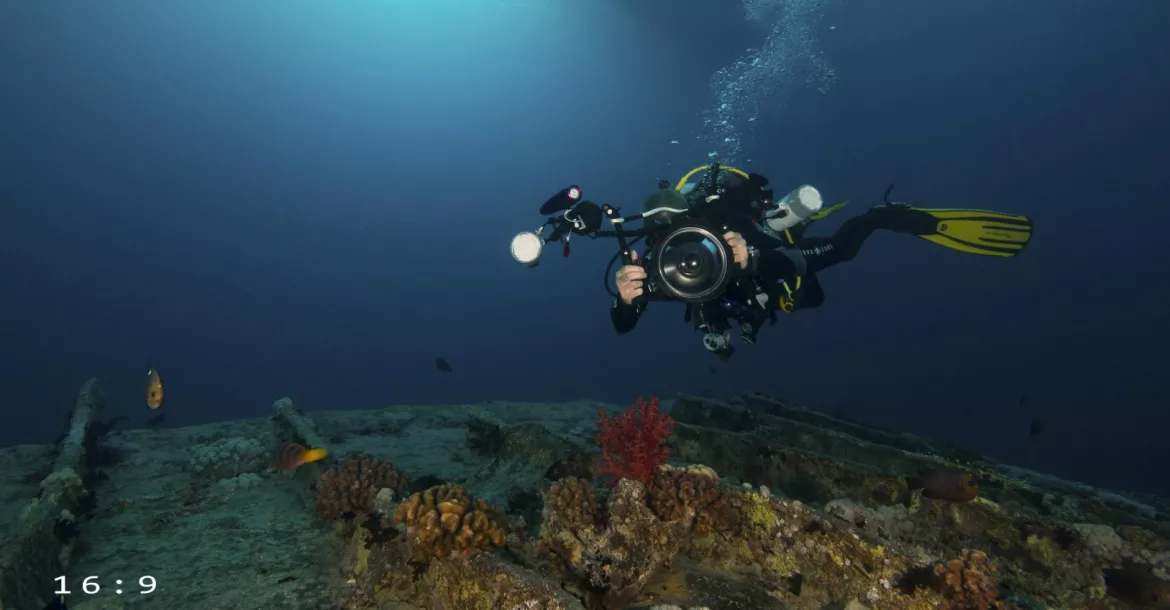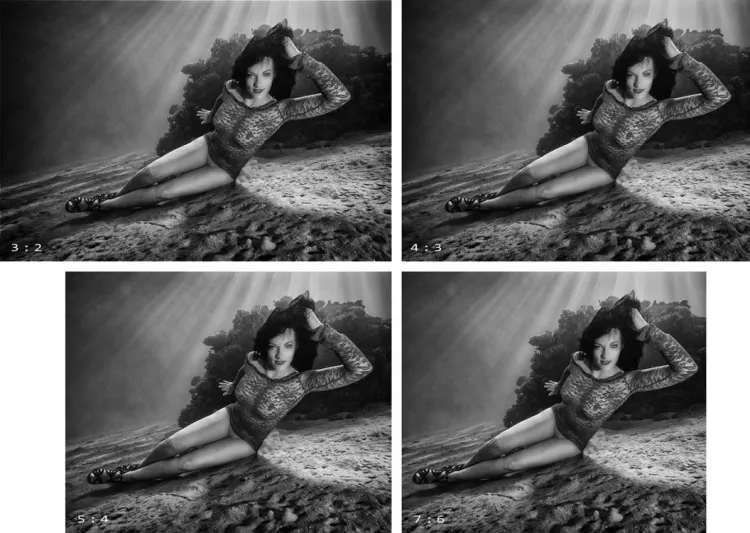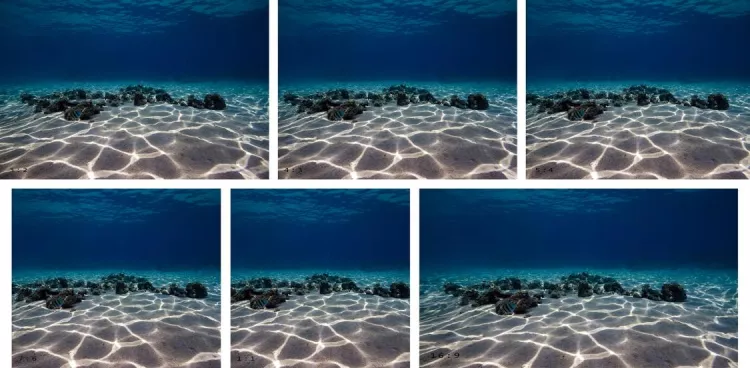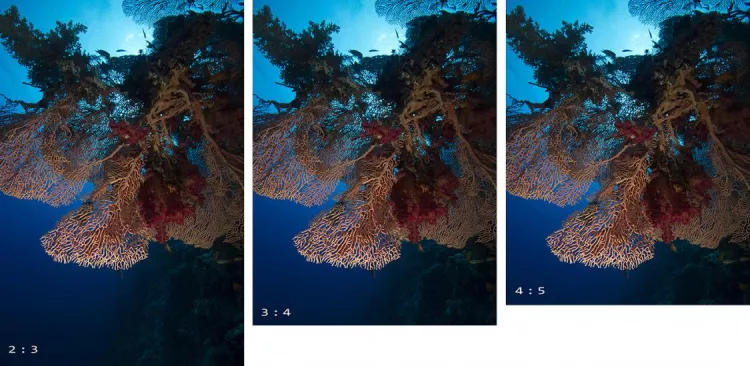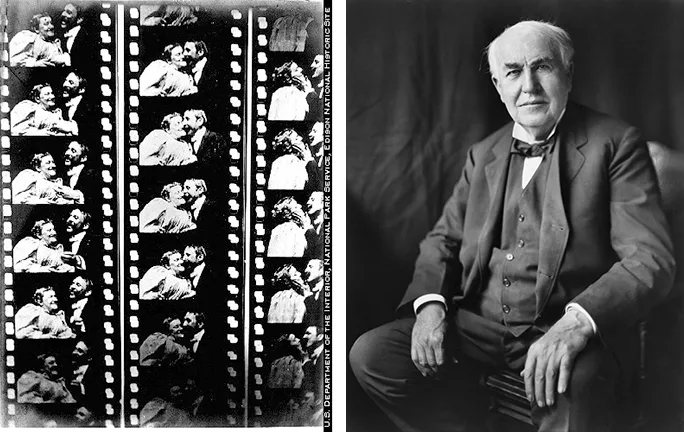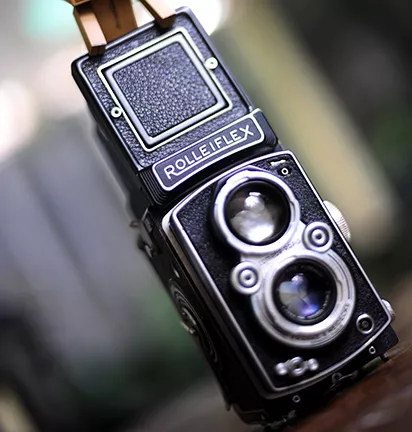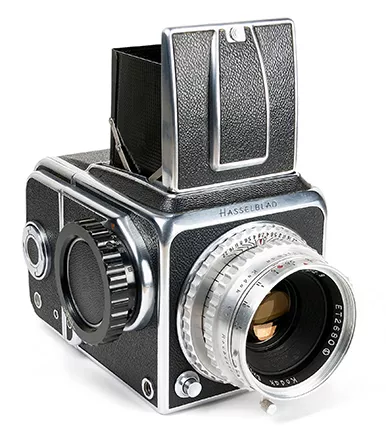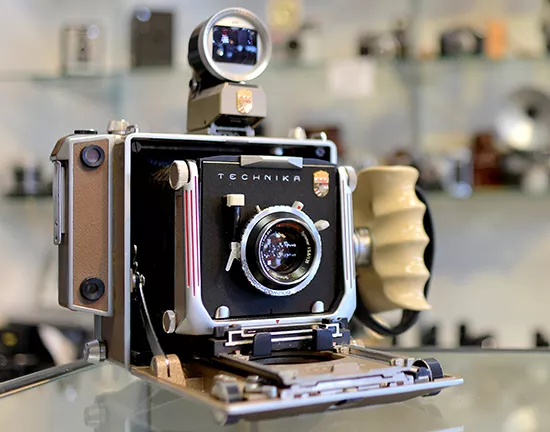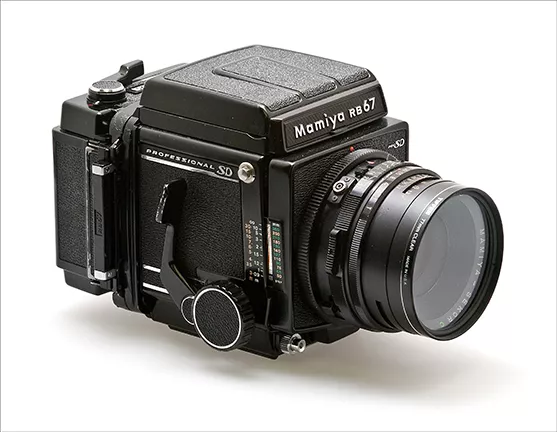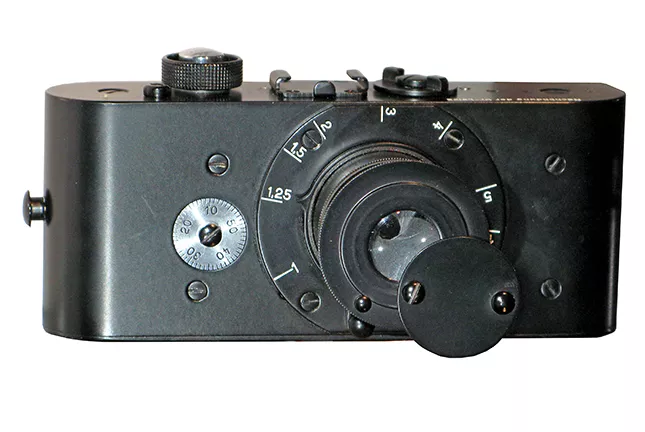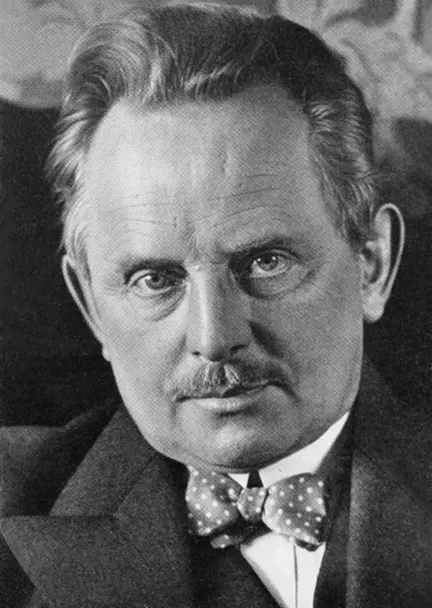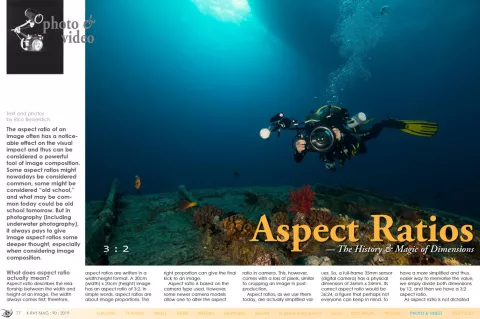The aspect ratio of an image often has a noticeable effect on the visual impact and thus can be considered a powerful tool of image composition. Some aspect ratios might nowadays be considered common, some might be considered “old school,” and what may be common today could be old school tomorrow. But in photography (including underwater photography), it always pays to give image aspect ratios some deeper thought, especially when considering image composition.
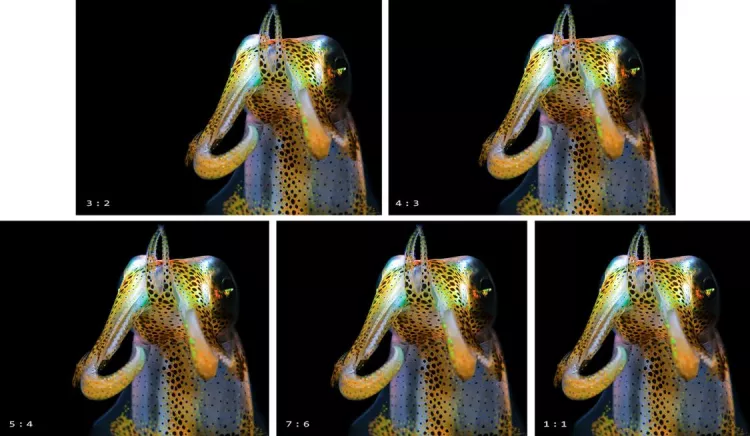
Contributed by
What does aspect ratio actually mean?
Aspect ratio describes the relationship between the width and height of an image. The width always comes first; therefore, aspect ratios are written in a width:height figure. A 30cm (width) x 20cm (height) image has an aspect ratio of 3:2. In simple words, aspect ratios are about image proportions. The right proportion can give the final kick to an image.
Aspect ratio is based on the camera type used. However, some newer camera models allow one to alter the aspect ratio in camera. This, however, comes with a loss of pixels, similar to cropping an image in post-production.
Aspect ratios, as we use them today, are actually simplified values. So, a full-frame 35mm sensor (digital camera) has a physical dimension of 36 x 24mm. Its correct aspect ratio would be 36:24, a figure that perhaps not everyone can keep in mind. To have a more simplified and thus easier way to memorize the value, we simply divide both dimensions by 12, and then we have a 3:2 aspect ratio.
As aspect ratio is not dictated by the size of a digital camera sensor (or film) but by its own proportions, the same story goes for sensors of crop cameras. Crop cameras have a smaller sensor—in many cases, one of approximately 22.5 x 15mm—but it can vary depending on camera model and brand. However, these measurements conform to the 3:2 aspect ratio of the full-frame sensor: The sensor is 1.5 times as wide as it is high.
Important to know: Aspect ratio has nothing to do with sensor size nor megapixels.
Let's have a look at some aspect ratios and see from where they came from, why they are in use, and what Thomas Edison has to do with all of it. We will then compare different aspect ratios and their effects to underwater images.
4:3
The 4:3 aspect ratio has a long history, which goes back as far as the paintings of the old masters. But as far as it concerns the imaging world, we can say this aspect ratio was invented in the lab of Thomas Edison himself. “About like this,” said Edison when he was asked what format he wanted for his silent film, forming a shape somewhat close to 4:3 with his fingers—so the story goes.
Edison's movie The Kiss (1886) was one of the first films ever shown commercially to public. In 1900, The Magician followed, and then in 1910, Frankenstein. Edison's Black Maria Studios was the first film production studio in the United States. One could say Black Maria created a standard. Of course, photography did exist at that time already. The so-called “full plates” (sometimes called “whole plates”) used in Daguerreotypes had a size of 6.5 x 8.5in, which is roughly 4: 3. However, when the images “learned to walk,” cinema (and not photography) did set the standard, as cinema was simply far more popular, thus breaking a path for the entire imaging industry.
For decades, the 4:3 aspect ratio was the standard for television and computer screens. When digital cameras hopped on stage in the 1990s, the 4:3 aspect ratio was the first thing they adopted. Still, most digital compact cameras (including point-and-shoot models) do use this aspect ratio, and it still remains the standard for most of the micro-four-thirds mirrorless cameras, several digital medium-format digital cameras and some medium-format film cameras, which use the 6 x 4.5cm format.
The 4:3 aspect ratio lends images that old-school feeling, and many old masters of fine art photography would never ever use any other ratio. Some of them have absolutely nothing good to say about the aspect ratio I will introduce next.
3:2
Oskar Barnack (1879-1936), the inventor of the Leica camera (yes, Leica) and of the 35mm film format, set the first stone on the path of the currently popular 3:2 aspect ratio. Barnack decided to use a double 4:3 cinema film frame, which then ended up in a 4:6 ratio—that is 3:2 when you turn it 90 degrees.
What is important to know is, that at the time of Barnack, photo cameras were far from being handy. His intention and invention was the development of a camera people could easily carry with them. Therefore, he invented the 35mm format, which was widely known as the “small format.” Nowadays, digital shooters call it the “full frame format,” but its origin was the small format.
The proportions of a 35mm film, or sensor, results in a 3:2 aspect ratio, and as such, became the standard for digital crop sensors and full-frame D-SLRs, and most film cameras. Also, a few (full-frame) mirrorless cameras and some high-end compact cameras use the 3:2 aspect ratio.
Images with the 3:2 ratio do look a bit “wider” than those with the 4:3 ratio, which was much welcomed by nature and landscape photographers, but received not-so-optimistic opinions from portrait photographers, who thought the 2:3 (vertical) was simply a bit too “tall.” But that did not stop the success and popularity of 35mm small-format cameras.
What is important to know is that the 35mm film format, with its resulting 3:2 aspect ratio, has its roots in the early days of cinema, and with a photographer, Barnack, who simply had had enough of carrying heavy and bulky cameras with him. Barnack suffered from asthma and was not a very sporty gentleman. The myth that pops up here and there, which states that the 3:2 aspect ratio was invented because it matched the mathematical proportions of the Golden Ratio of art and architecture, is simply wrong. The 3:2 ratio does not even come close to the Golden Ratio.
A sniff into history
The early days of photography and film formats were days of a lot of confusion, as film formats were arbitrary and specific to each camera model. For example, Kodak start making “pocket cameras” as early as 1885, but each model used a different (film) format. In 1916, Kodak had 30 different models with more than a dozen different film formats. Aside from Kodak, other camera manufacturers did their own thing as well—hence, days of confusion.
The first film cameras made by Nikon and Minolta used the 4:3 aspect ratio; but later, they changed their plans and followed the better-selling 3:2 standard.
1:1
The 1:1 (formerly 6:6, or just simply “square”) aspect is in a class of its own. It existed for quite a while but had its first glorious moment in 1929 when Rollei launched its first twin-lens camera, the legendary Rolleiflex TLR. A successor of this model was, by the way, the first camera ever used for commercial underwater photography by the pioneering diver Hans Hass. Some of you divers of the older generation might still remember the legendary Rollei Marine camera.
The Rolleiflex was copied many times. The first camera of mine was a Weltaflex—a Rolleiflex copy made in East Germany.
Hasselblad later followed the hype, utilizing the 1:1 aspect ratio by using a 6 x 6cm film in its model 1600F in 1948. Years later, the very first image of planet Earth seen from space was made with a Hasselblad (model 500EL, with 6 x 6cm film)—perhaps the most famous 1:1 photograph ever made.
From a compositional point of view, not much can be said about 1:1 square format. The “why” of this aspect ratio might be answered with technical aspects, not with aesthetic aspects.
However, the super-old-school 1:1 ratio has never been forgotten or buried. Sixty million images with the 1:1 aspect ratio are uploaded daily to Instagram, which proves that 1:1 never dies.
5:4
The 5:4 aspect ratio is the standard in large format photography. There is, as yet, no large format digital camera sensor, so film is it for now. However, large format film cameras are still produced and available on the market—for example, the Linhof Master Technika 3000. An upscaled version of the 5:4 aspect ratio is the 10:8 aspect ratio, a very popular print size and proportion.
7:6
The 7:6 aspect ratio is the classic aspect ratio of medium format film photography—namely, with Pentax and Mamiya cameras. However, modern digital medium format cameras moved away from that dinosaur. The Hasselblad X1D works with a 4:3 aspect ratio, and the Leica S-Series of cameras—despite being medium format—surprisingly work with 3:2 aspect ratio. Fujifilm goes even one step further, offering its users seven different aspect ratios from which to choose (in-camera). However, FujiFilm's digital medium format cameras native aspect ratio is 4:3. Different aspect ratios offered in the menu of a camera itself always come along with a loss of pixels and resolution. However, with a 50+ megapixel sensor, there is a lot of ground to play with.
16:9
For decades, people have been used to viewing images in the 4:3 or 3:2 aspect ratios. This is, in some way, still the case; but in the meantime, a new player has entered the field—the 16:9 aspect ratio.
Known as HDTV Standard, this aspect ratio is now used in television screens, computer screens, and last but not least, in all smartphone screens. But smartphones are a “critical case,” as their screen aspect ratio is actually 9:16, simply dictated by users holding their smartphones (even when taking photos or movies) in a vertical position.
The 16:9 aspect ratio is also called “widescreen,” and that is exactly what it is—a nice, wide proportion suitable for landscapes, and furthermore, perhaps suitable to attract the clients of tomorrow. Several early Panasonic compact cameras used the 16:9 aspect ratio, but modern digital cameras usually work with the 3:2 or 4:3 aspect ratios, offering the 16:9 aspect ratio as a selectable in-camera option.
Making creative use of aspect ratios
Whether it is provided by your camera as a native or optionable image aspect ratio, or you just help yourself by cropping in post-production, an awareness of the impact different aspect ratios have will certainly improve the composition of your image. Not every image must be in a 3:2 aspect ratio, for example, just because this is what your camera provides. You often can improve composition by selecting a different aspect ratio in camera (some newer cameras support such functions) or by cropping your image in any image editing software of your choice.
You might lose some pixels, yes, and you might have a limitation in maximum print size; but nowadays, where 24MP (megapixels) are considered “amateur class,” 36MP are considered “mid-range,” and 50MP (or more) are considered “professional,” one should not worry too much. No one needs a 36MP (or even 50MP) image resolution to get a photo published full-page sized in a magazine.
However, when working with aspect ratios as tool of image composition, it is generally recommended that one stick with common aspect ratios. A “fantasy aspect ratio” is, in terms of aesthetics in photography, a risky thing. It is better to stick with the standards, as these do exist for a reason.
Which aspect ratio to use pretty much depends on the subject or scene photographed. A 1:1 ratio might not work well with an underwater landscape scene, but a 3:2 or even a 16:9 ratio does. If a 2:3 portrait (vertical) proportion comes with slightly too much negative space, a 3:4 aspect ratio might be the better choice. The classic 5:4 aspect ratio has a sort of “compact” visual output, which makes it suitable for close-ups, macro shots and fish portraits. This is also true for the 7:6 aspect ratio.
It always pays to just give it a try. Try and check whether a different aspect ratio (other than the native one) improves your image or not. Luckily, image editing software such as Photoshop or Lightroom (and many other software programs) offer you several common aspect ratios when you use the crop tool.
Last word
There are several image aspects ratios in existence. This article has just listed the most common ones in photography. Explore the possibilities. ■
Rico Besserdich is a widely published German photographer, journalist and artist based in Turkey. For more information, visit: Maviphoto.com. See his latest book at: Songofsilence.com.

